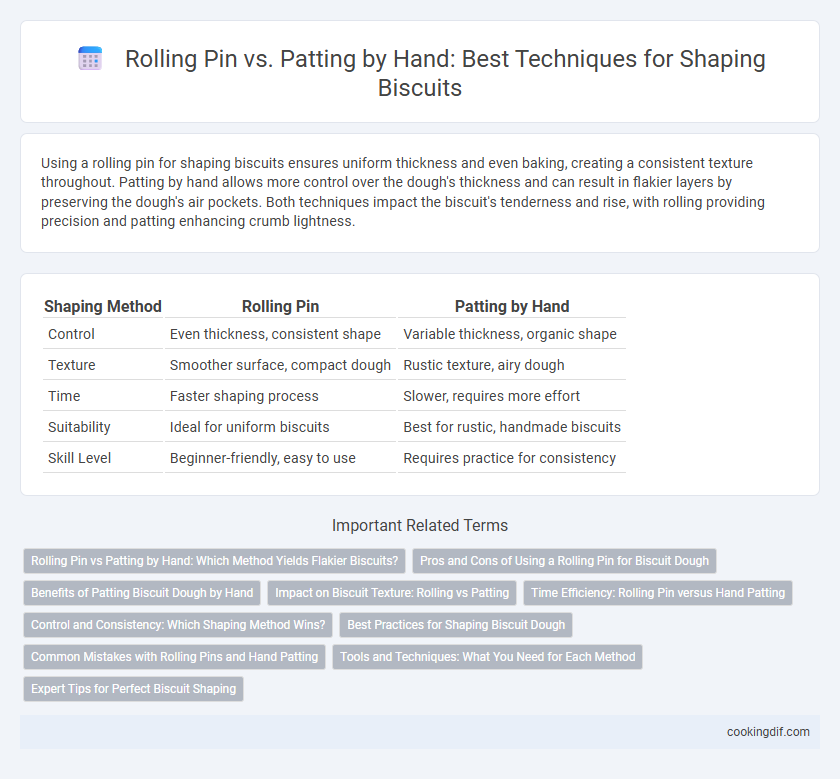Using a rolling pin for shaping biscuits ensures uniform thickness and even baking, creating a consistent texture throughout. Patting by hand allows more control over the dough's thickness and can result in flakier layers by preserving the dough's air pockets. Both techniques impact the biscuit's tenderness and rise, with rolling providing precision and patting enhancing crumb lightness.
Table of Comparison
| Shaping Method | Rolling Pin | Patting by Hand |
|---|---|---|
| Control | Even thickness, consistent shape | Variable thickness, organic shape |
| Texture | Smoother surface, compact dough | Rustic texture, airy dough |
| Time | Faster shaping process | Slower, requires more effort |
| Suitability | Ideal for uniform biscuits | Best for rustic, handmade biscuits |
| Skill Level | Beginner-friendly, easy to use | Requires practice for consistency |
Rolling Pin vs Patting by Hand: Which Method Yields Flakier Biscuits?
Using a rolling pin compresses the biscuit dough more evenly, often resulting in a denser texture, while patting by hand preserves air pockets that contribute to flakier layers. Patting gently with your hands maintains the dough's integrity and prevents overworking, which is crucial for achieving tender, flaky biscuits. Studies and baker testimonials consistently favor hand-patting for its ability to yield light, flaky biscuit layers compared to the uniform compression of a rolling pin.
Pros and Cons of Using a Rolling Pin for Biscuit Dough
Using a rolling pin to shape biscuit dough creates a uniform thickness that promotes even baking and consistent texture throughout the batch. However, it can overwork the dough if pressed too hard or rolled excessively, potentially resulting in tougher biscuits due to gluten development. Compared to patting by hand, the rolling pin offers precision and speed but lacks the gentle touch that preserves biscuit flakiness and rise.
Benefits of Patting Biscuit Dough by Hand
Patting biscuit dough by hand preserves the dough's delicate texture and prevents overworking, resulting in tender, flaky biscuits. This method allows for more control over thickness and shape, ensuring even baking and a consistent rise. Hand-patting also minimizes gluten development, which can make biscuits tough when rolled with a pin.
Impact on Biscuit Texture: Rolling vs Patting
Rolling pins create a uniform, dense biscuit texture by evenly flattening dough, which can sometimes result in a tougher crumb. Patting by hand preserves air pockets in the dough, producing a lighter, flakier biscuit with a more tender bite. The choice between rolling and patting directly affects biscuit crumb structure and overall softness, crucial for desired biscuit quality.
Time Efficiency: Rolling Pin versus Hand Patting
Using a rolling pin to shape biscuits significantly reduces preparation time by evenly flattening dough in seconds, while hand patting requires more time and effort to achieve a uniform thickness. Rolling pins provide consistent pressure, ensuring biscuits bake evenly, which can improve overall cooking efficiency. Relying on hand patting may lead to uneven biscuits and increased baking time due to variable thickness.
Control and Consistency: Which Shaping Method Wins?
Rolling pins provide superior control and consistency when shaping biscuit dough, allowing for even thickness and uniform edges that promote even baking. Patting by hand offers a more rustic texture but can lead to irregular shapes and varying thickness, affecting bake times and final texture. For bakers prioritizing precision and repeatable results, the rolling pin remains the optimal tool for shaping biscuits.
Best Practices for Shaping Biscuit Dough
Using a rolling pin for shaping biscuit dough ensures even thickness and consistent rise, optimizing texture and fluffiness. Patting by hand minimizes gluten development, leading to tender, flaky biscuits with a delicate crumb. Best practices recommend gently patting dough to desired thickness and finishing with a light roll for uniformity without overworking.
Common Mistakes with Rolling Pins and Hand Patting
Using a rolling pin for biscuit shaping often leads to overworking the dough, causing tough, dense biscuits instead of light, flaky layers. Hand patting, while gentler, commonly results in uneven thickness, which affects uniform baking and texture. Avoid pressing too hard with either method to maintain the dough's delicate air pockets essential for flaky biscuit structure.
Tools and Techniques: What You Need for Each Method
Using a rolling pin ensures even pressure and uniform thickness when shaping biscuits, providing a smooth surface ideal for consistent baking results. Patting dough by hand requires minimal tools--just clean hands and a flat surface--allowing greater control over thickness and texture, often leading to a flakier biscuit. Both techniques benefit from lightly floured surfaces and chilled dough to prevent sticking and maintain shape during baking.
Expert Tips for Perfect Biscuit Shaping
For perfect biscuit shaping, experts recommend using a rolling pin to achieve an even thickness, ensuring uniform baking and consistent texture throughout. Patting dough by hand preserves its delicate layers, resulting in flakier biscuits with a tender crumb. Combining gentle hand patting after an initial roll can optimize both thickness control and flaky structure for bakery-quality biscuits.
Rolling pin vs Patting by hand for shaping Infographic

 cookingdif.com
cookingdif.com